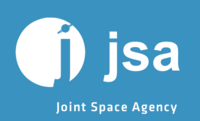Joint Space Agency: Difference between revisions
Notbyzantium (talk | contribs) No edit summary |
Neuleinster (talk | contribs) No edit summary |
||
| Line 13: | Line 13: | ||
|{{flag|Arthurista}} | |{{flag|Arthurista}} | ||
|{{flag|Belfras}} | |{{flag|Belfras}} | ||
|[[Besmenien]] | |||
|{{flag|Cavarzere}} | |{{flag|Cavarzere}} | ||
|{{flag|Enyama}} | |{{flag|Enyama}} | ||
| Line 51: | Line 52: | ||
* {{flag|Arthurista}} | * {{flag|Arthurista}} | ||
* {{flag|Belfras}} | * {{flag|Belfras}} | ||
* [[Besmenien]] | |||
* {{flag|Cavarzere}} | * {{flag|Cavarzere}} | ||
* {{flag|Fakolana}} | * {{flag|Fakolana}} | ||
Revision as of 21:37, 12 March 2020
This article is incomplete because it is pending further input from participants, or it is a work-in-progress by one author. Please comment on this article's talk page to share your input, comments and questions. Note: To contribute to this article, you may need to seek help from the author(s) of this page. |
 | |
| Abbreviation |
|
|---|---|
| Formation | 30 May 1961 |
Parent organisation | |
The Joint Space Agency is a multinational confederation of national space agencies and private corporations dedicated to the exploration of space. It was conceived in the 1960s as a means for countries to pool resources together to jointly develop a civilian aerospace program in a more cost-effective manner than purely national endeavours. It currently engages in both manned and unmanned scientific missions, as well as commercial satellite launches, with which the JSA is largely self-financing. Its main spaceports are the International Launch Centre located in Sante Reze, and the Pyrkagies Institute of Rocketry in southern Tarsas.
Current members
Membership in the JSA is split into two categories. Full members are states or entities which provide the balance of the JSA's funding, technology or personnel. Associate membership entails a lesser level of commitment and these members participate in the JSA in a more ad hoc or occasional basis. Only full members participate in executive decision-making for the Agency as a whole, although associate members which participate in specific missions may have significant influence in relation to those missions.
Full members
 Arthurista
Arthurista Belfras
Belfras- Besmenien
 Cavarzere
Cavarzere- Template:Country data Fakolana
 Ghant
GhantLatium
 Lihnidos
Lihnidos Lion's Rock
Lion's Rock Lyncanestria
Lyncanestria Ostrozava
Ostrozava Sante Reze
Sante Reze Thraysia
Thraysia Vannois
Vannois Yisrael
Yisrael
Associate members
Launch systems
The Joint Space Agency currently operates three launch systems.
The Athena IV is a medium-lift launcher originally developed from an Arthuristan FOBS-capable ICBM design which, whilst derided as 'insane' as a weapons system and quickly cancelled whilst still in the design stage, proved to be an astute choice for repurposing as a launch vehicle. Capable of lifting 7,500kg of payload to the Low Earth Orbit ('LEO') and 4,500kg to the Geostationary orbit ('GEO'), it is cost-effective 'workhorse' vehicle, mostly used for commercial launches. The Athena V is a heavy lift vehicle capable of carrying 28,000kg of payload to the LEO and 15,000 to the GEO. It is also the means by which the JSA's crewed orbiter system is launched.
Recently, a third launch system, the Horus 9, has been added to the JSA's repertoire. It is optimised for the launch of light to medium payload utilising a reusable booster system, aimed at significantly reducing future launch costs for commercial undertakings.
Pegasus Crewed Orbiter System
The Pegasus Crewed Orbiter System (PCOBS), introduced in 1985, is the main spacecraft employed by the JSA for manned missions to the Low Earth Orbit and beyond. It is a combination of three parts: the service module, the cockpit module and the habitation module. The are two variants of the service module: The standard LEO model an the lunar model, which is an enlarged and extended variation of the former packing additional batteries, fuel and fuel cells.
It is launched using the Athena V heavy lift system. Re-entry is accomplished using the cockpit module alone, which is equipped with an ablative heat shield, parachute and flotation aid for ocean surface recovery.
The habitation module may be modified with different docking ports for access to various national and international space station projects. A proposed third variant of the service module – the Extra-Lunar model, is undergoing development, which would allow the Pegasus to conduct manned missions to the near-earth asteroids and beyond.

